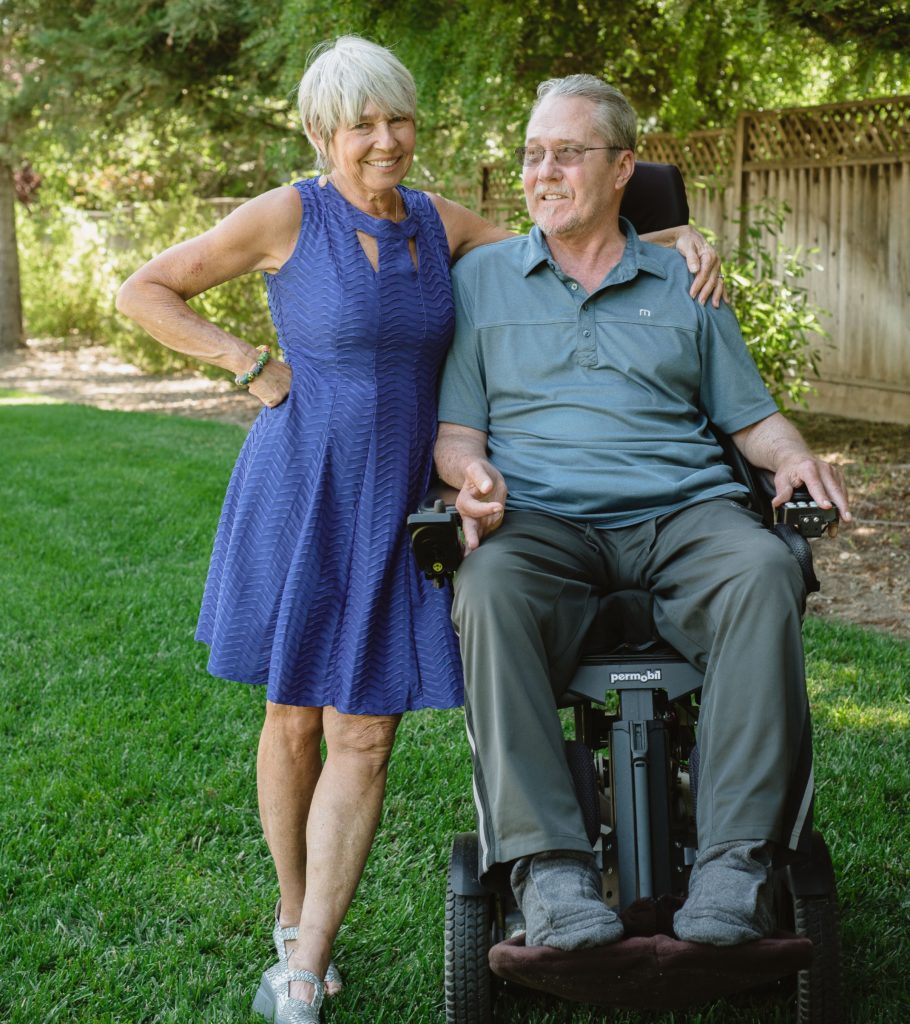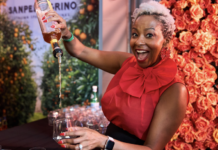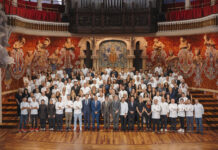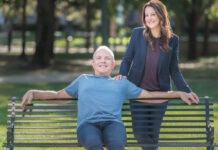Contributed By Greta Salmi
Looking to the Future
Because my husband’s Muscular Dystrophy gets progressively worse, and is carried by a dominant gene, we have a lot to worry about for the future. The tricky balance–living as a spouse and caregiver, while still enjoying today and planning for the future.
This is the 4th part of the series.
Two years ago, Joel and I realized our travel days together, including car trips, were over. Joel needed more help managing his Muscular Dystrophy symptoms and could be alone less and less. It became clear that we needed paid help, when I was away from the house. At first, I was worried about the expense and Joel was not eager to have other people help him. Being raised Jewish, I also felt guilty that I couldn’t do it alone. Our four grown children and their spouses often offered to do things for us. “Make us dinner, or help Joel eat,” I would tell them. Joel needs such intimate care that it is too uncomfortable to take more help from our kids. I tried to make the care look easy but eventually I realized that it isn’t.
We now have help three to four mornings a week, almost twenty hours per week, so I can run errands and do what I need to do (and sometimes have an unplanned hour to do whatever I want). I can finish a chapter in a book. I can linger at the market. I can visit a friend or call one of our kids, without warning them that I’ll have to call back if Joel needs me. I don’t want to call anyone back. I want to finish a conversation. I am always watching to make sure I am home in time for the end of the shift, but still, the time is a luxury that I revel in.
Advertisement
Once every other month, I take a twelve-hour day to visit our son’s family, who lives a three-hour drive away. I also have a week at a time, two or three times a year, to go back East to see the two kids who went to college there and stayed, building families and lives. Our East Coast kids and families come to visit us, as they know Joel can’t travel, and we happily help them pay for their trip. These are not luxuries; these are needs. And although these are very expensive – good, around-the-clock home health care costs us $4,200 a week – these necessary breaks are getting figured into the budget.
I sometimes say that since we pay our home health care providers a good wage, they now can take the European vacations that we once took. It’s sort of a joke, but it’s also true. Being a counter, I am constantly doing the financial calculations. If I stay at this luncheon, it will cost $150 in care. This panel discussion is two hours plus travel, costing $75. I constantly ask myself: Is this time away worth the money?
I am also acutely aware of the language I use to describe Joel’s care. “Helping someone to eat” is so different from saying “I feed him his meals.” “Helping someone with hygiene” presents a different image than saying “I wash and clean him.” I want people to see the difference and use language that recognizes his humanity and his dignity, and I model that language with everyone who works with us. We have grown very close to the two women who help us. We feel that that they care about him as well as care for him. I can tell they care about me as well.
My sleep has also changed. Since Joel can’t turn over in his sleep – immobility can lead to sores or pain – I need to turn him. It’s not as simple as sleepily pushing Joel onto his back or his side. It means a retinue of pillows to support legs that weigh heavily on themselves and can cause pressure sores if not done right. It takes three minutes to get him on his side, it takes four to turn him on his back, as I have to move the adjustable bed up and position the pillow. A good night is being up twice, with three to four hours between moves.
But a sore shoulder requires more moves. Drinking too much water late in the evening can result in having to help Joel urinate. He wakes me up with “Sweetheart, I need to turn.” It helps to hear the “Sweetheart” and then the “thank you” that always follows. I think of newborns and all the sleepless nights we had as parents. I do believe that it stretches my compassion muscle and makes me appreciate all the ways people struggle with sleep. Resentment creeps in after bad nights. I am working to subdue that.

Like most people in love, we cherish our moments of intimacy. Date afternoons require privacy, which means planning to not have home health care, doctor appointments or anyone dropping by. Being intimate with someone who is almost a quadriplegic would be easier if I had had a previous career as a gymnast with Cirque du Soleil. Gymnasts can move in ways most of us can’t imagine. Quadriplegics can’t move a thing! That means that my body has to do all the moving. It doesn’t help that I am now in my seventies and not as limber as I was, but my sense of humor has remained intact, and so has my husband’s. Knowing I am going to make love with Joel does wonders for getting over anger about matters big and small. And giving up on anger is the only way I have found to truly enjoy my life.
We’ve kept our sense of humor, but one problem we are now struggling with is the temperature in the house. It is always summer at the Salmi’s. Since Joel can’t move, he can’t generate his own warmth. His optimum room temperature is 76-78 degrees Fahrenheit. Meanwhile, I’m pulling and tugging on slings and arranging blankets and moving all the time, generating lots of heat. I dress in shorts and sleeveless tops while Joel wears a sweater. I think of the Saturday Night Live sketch called “Alexa for Seniors,” which includes an older woman bundled up in blankets on her sofa. She asks Alexa to turn up the heat. Alexa responds: “It is already 100 degrees in here.” I carry that scene in my head, and it provides me with an inner giggle and some solace.
Advertisement
A Rare Form of Muscular Dystrophy
Most people our age (aka Boomers) know about Muscular Dystrophy from Jerry Lewis telethons, and “Jerry’s kids.” These boys had Duchenne MD, which attacks voluntary and involuntary muscles, and usually ends the person’s life by their early twenties.
Joel’s type of MD is so different. It is late adult onset, and it does not attack involuntary muscles. That means that the heart and lungs and so on can function unharmed forever. A person becomes increasingly unable to walk, then loses the use of their arms, and core muscles can be weakened. That person can live a long time, gradually becoming a quadriplegic. They can talk, eat and precariously sit up. They essentially become a prisoner of their own bodies. They die of something else besides MD. Very few families in the world have this form of inherited MD. That makes my husband’s family unique. Heartbreakingly unique.
At age three, one of our granddaughters asked me, “Do you help Grandpa eat all his meals?” I answered, “Yes, I do.” She thought for a moment, and said, “Maybe when he grows up, he can feed himself.” That made me laugh then and it makes me laugh now.
The future, of course, is much more settled. Joel won’t be able to ever again feed himself with utensils or hold a glass. But that doesn’t stop us from having Happy Hour on the front porch or visiting with friends over a glass of wine in the park. With a bendable straw in a glass, or finger food positioned just exactly right on the edge of a counter, he can still experience a modicum of independence. For a few more years – or maybe months.
Knowing that if you have the gene, you will have the disease makes me anxious about the next generations, including my stepdaughter and her children, our grandkids. The gene is now identifiable with a lab test, and she and her cousins do not want to be tested. If they test positive, some of them say, it could cost them life or long-term care insurance. Others say they’re just not ready to know. For us, knowing when Joel was forty-one allowed us to make plans to travel as extensively as we could, knowing that sometime in the future, it might not be possible. Some days when I watch Joel struggle, I am consumed with the need to know if my stepdaughter and grandchildren will be next.
My older sister says that people who have diseases like my husband have a particular opportunity for their soul to learn much in this life. She says that souls stand in line to get disabled bodies in their reincarnation. My husband says that he did NOT get into the line on his own but was pushed there. I don’t think souls choose disease or disaster, but to exist is to embrace struggle and learn whatever lessons our struggles can teach us. I think about the Zen lessons I am learning, like not pushing too hard on the Hoyer Lift because a light touch makes it move more easily. It’s a lesson I hold close to my heart. Joel works on changing his tone of voice and gives me an extra second if I need to do something I have forgotten. I am learning to see if I can view what feels like a criticism as necessary direction. Our better selves are more present some days than others.
I would like to say I am at peace with whatever happens, but I often am not. My husband refuses to look too far into the future. Facing Joel’s future can make us weep.
Most of the time, my focus is just like everyone else’s. Will I get my work done in a timely fashion? What’s the best way to avoid traffic? What to fix for dinner? When do I get to see the grandkids next? All those lovely little decisions make up life and get woven into a sense of stability and comfort. I don’t think too far into the future because most of my energy goes into figuring out today.
Joel’s fear that I would eventually leave him has been answered by our twenty-nine years together since his diagnosis. Ours is a story of learning how to figure things out. It is also a love story. No, I don’t want to leave him, and I don’t want to lose him. I am not always as quick to help him as a paid caregiver would be, but I am the one who kisses the neck I am lifting, and sees his eyes shining when we are ready to face the day.
______________________________________________________________
Medical Breakthrough
Starting in the 1980’s, Dr. Thomas Bird, a world expert on neurogenetics working out of the University of Washington, began studying a rare form of Muscular Dystrophy. He and his team were studying the cause of the disease of the O’Connell family, my husband’s family. Through years of research and genetic contributions from many family members, they were able to identify this as an Ultra-Rare disease, Myofibrillar myopathy, one of many in the MD disorder. Only four families world-wide have been identified with this. While there is no treatment or prevention, by 2009, Dr. Bird identified the exact gene that mutates to cause this autosomal dominant gene which determines the disease. A simple blood test is now available to family members to test for the presence of the mutated gene.
______________________________________________________________
GRETA SALMI lives with her husband, Joel, in the S.F. Bay Area. She coaches educators and was a school principal for nineteen years. She can be reached via Twitter, @GretaSalmi.
For More Information: Contact the Muscular Dystrophy Association for support and guidance, https://www.mda.org/.


































